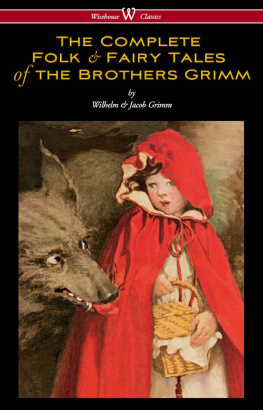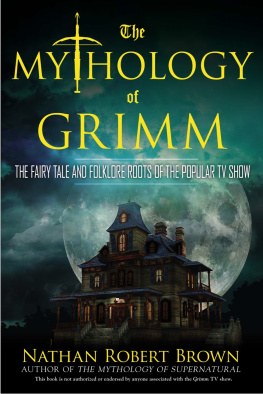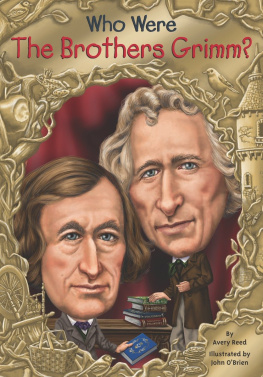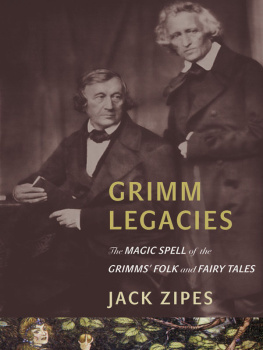ROUTLEDGE LIBRARY EDITIONS: FOLKLORE
Volume 3
THE BROTHERS GRIMM
THE BROTHERS GRIMM
RUTH MICHAELIS-JENA
First published in 1970
This edition first published in 2015
by Routledge
2 Park Square, Milton Park, Abingdon, Oxon, OX14 4RN
and by Routledge
52 Vanderbilt Avenue, New York, NY 10017
Routledge is an imprint of the Taylor & Francis Group, an informa business
1970 Ruth Michaelis-Jena
All rights reserved. No part of this book may be reprinted or reproduced or utilised in any form or by any electronic, mechanical, or other means, now known or hereafter invented, including photocopying and recording, or in any information storage or retrieval system, without permission in writing from the publishers.
Trademark notice: Product or corporate names may be trademarks or registered trademarks, and are used only for identification and explanation without intent to infringe.
British Library Cataloguing in Publication Data
A catalogue record for this book is available from the British Library
ISBN: 978-1-138-84217-5 (Set)
ISBN: 978-1-138-84251-9 (Volume 3)
Publishers Note
The publisher has gone to great lengths to ensure the quality of this reprint but points out that some imperfections in the original copies may be apparent.
Disclaimer
The publisher has made every effort to trace copyright holders and would welcome correspondence from those they have been unable to trace.
RUTH MICHAELIS-JENA
The Brothers Grimm
LONDON
ROUTLEDGE & KEGAN PAUL
First published 1970
by Routledge & Kegan Paul Ltd
Broadway House, 6874 Carter Lane
London, E.C.4
Printed in Great Britain
by T.&A. Constable Ltd
Hopetoun Street, Edinburgh
Ruth Michaelis-Jena 1970
No part of this book may be reproduced
in any form without permission from
the publisher, except for the quotation
of brief passages in criticism
ISBN 0 7100 6449 7
For
A. J. J. R.
Contents
Throughout the text and with illustrations relating to the period the old spelling of Cassel has been kept, otherwise modern usage has been adopted.
THE decoration on the title page represents the ex-libris of Philipp Wilhelm Grimm, now in the Brder Grimm Museum, Kassel.
Illustrations in the text, reproducing drawings of the contemporary scene by Ludwig Emil Grimm, are from his Reisetagebuch in Bildern, 1850, in the Brder Grimm Museum, Kassel. The everyday articles and designs of the period are from records, and the collections of the Bergwinkel Museum, Schlchtern.
THE Nursery and Household Tales have spread the fame of the Brothers Grimm everywhere. Jacob and Wilhelm Grimm made their collection in Kassel.
It was England, however, that gave the world the first important translation. In 1823, following the rendering of a few stories into Danish (1816) and a translation into Dutch (1820), Edgar Taylor published his translations. In doing so, he introduced the Grimms to the English-speaking nursery where they have been firmly established ever since. But, more remarkable than that, Taylors work formed the basis for numerous translations into other languages, so that today many children all over the world find enjoyment in the old stories. Adults recapture the pleasures of their own childhood in them, and increasingly attention has been focused on the folktale as a subject for serious enquiry.
Like a golden net these fairytales have drawn together people far apart in time and space.
The present book shows that the brothers deserve our respect and affection also for reasons other than the discovery of the Mrchen. As scholars they laid the foundations for the study of Germanic language and literature, and many of their books are still indispensable to the student. As human beings they were lovable, possessed of a sense of friendship and fairness, of integrity and incorruptibility in politically difficult times.
I am happy that the Murhardsche Bibliothek der Stadt Kassel und Landesbibliothek, successor to the library where the brothers spent many of their working years, and the Brder Grimm Museum, have been able to play a part in the making of this valuable and delightful book.
Kassel/Germany | Ludwig Denecke |
INTEREST in the Brothers Grimm goes back to my childhood, fostered early by my mother who like the Grimms came from Hesse, and my patient story-telling father. Many years after I conveyed my enthusiasm to my late husband, with whom I translated some of the lesser known tales from the Grimm collections. He in turn supported my researches, and shared the initial stages of the work.
It is my pleasant duty to thank the many friends who have helped me over years, first and foremost Dr. Ludwig Denecke, emeritus Director of the Murhardsche Bibliothek der Stadt Kassel und Landesbibliothek, incorporating the Brder Grimm Museum. I have benefited much from his wise counsel and his valuable suggestions during the preparation of my manuscript. The staff of his library have never tired in giving me their amicable assistance. On account of an unpublished letter in his possession, Kassels archivist, Dr. Robert Friderici, let me into the secret of how the brothers met their Fairytale-Wife, and allowed me to use the information.
Brgermeister Dsor of Steinau, Dr. Karl Dielmann, Director of the Kulturamt in Hanau, Wilhelm Hansen, Director of the Landesmuseum in Detmold, Dr. Hans Hornung, Director of the Stiftung Preussischer Kulturbesitz, Wilhelm Praesent, of the Bergwinkel Museum in Schlchtern, and nearer home, Dr. Katharine M. Briggs, of Oxford, Dr. Gotthard Guder, Senior Lecturer in the Department of German in the University of Glasgow, and the Curator of the Edinburgh Museum of Childhood, Patrick Murray, have all given encouragement and good advice.
A Grimm freemasonry stretches across Europe, and I have been warmly welcomed, and guided by Professor Sandor Kozocsa, of Budapest, Professor Leopold Schmidt, of Vienna, and Professor Pavel Trost, of Prague.
I remember with gratitude the late Nora Hassenpflug, great-granddaughter of die liebe Lotte, the Grimms beloved sister, who made me feel at home in the Grimm family circle, also the much lamented Dr. Calum Maclean, of the School of Scottish Studies, with whom I was able to discuss many points.
The extract from the letter by Sir Walter Scott on pp. 1735 is reproduced from the centenary edition of The Letters of Sir Walter Scott (Constable & Co. Ltd. 19527) by kind permission of the publishers. I am also indebted to Elwert, publishers, of Marburg, Lahn, for permission to reproduce my translation on pp. 1512 of an extract from Isidor Levins essay, published in the Grimm Gedenken.
There are many more who must remain unnamed, like the kind nursing sister who showed me round the Haxthausen manor house of












